University Assignment: 5COM1057 Report on Atmel AVR Architecture
VerifiedAdded on 2022/09/06
|7
|3073
|19
Report
AI Summary
This report provides a comprehensive overview of the Atmel AVR architecture, focusing on its application in digital clocks. It begins with an introduction to digital clocks and the Atmega328p microcontroller, highlighting its features like minutes, seconds, hours display, battery standby, and alarm functionalities. The report then delves into the AVR architecture, including its RISC model, instruction set, and on-chip peripherals such as ADC, I2C bus, and timers. It explores the ATMEGA328p interrupts, external hardware interfacing, and the use of seven-segment displays in digital clocks. The report further discusses the program code, critical evaluation of the digital clock system, and a review of related research, including alternative microcontrollers and design approaches. The report emphasizes the practical aspects of the design, including component selection, programming, and battery life considerations, providing a thorough analysis of the AVR architecture and its practical applications in embedded systems.

Running head: ATMEL AVR
ATMEL AVR
Name of the Student:
Name of the university:
Author’s note:
ATMEL AVR
Name of the Student:
Name of the university:
Author’s note:
Paraphrase This Document
Need a fresh take? Get an instant paraphrase of this document with our AI Paraphraser
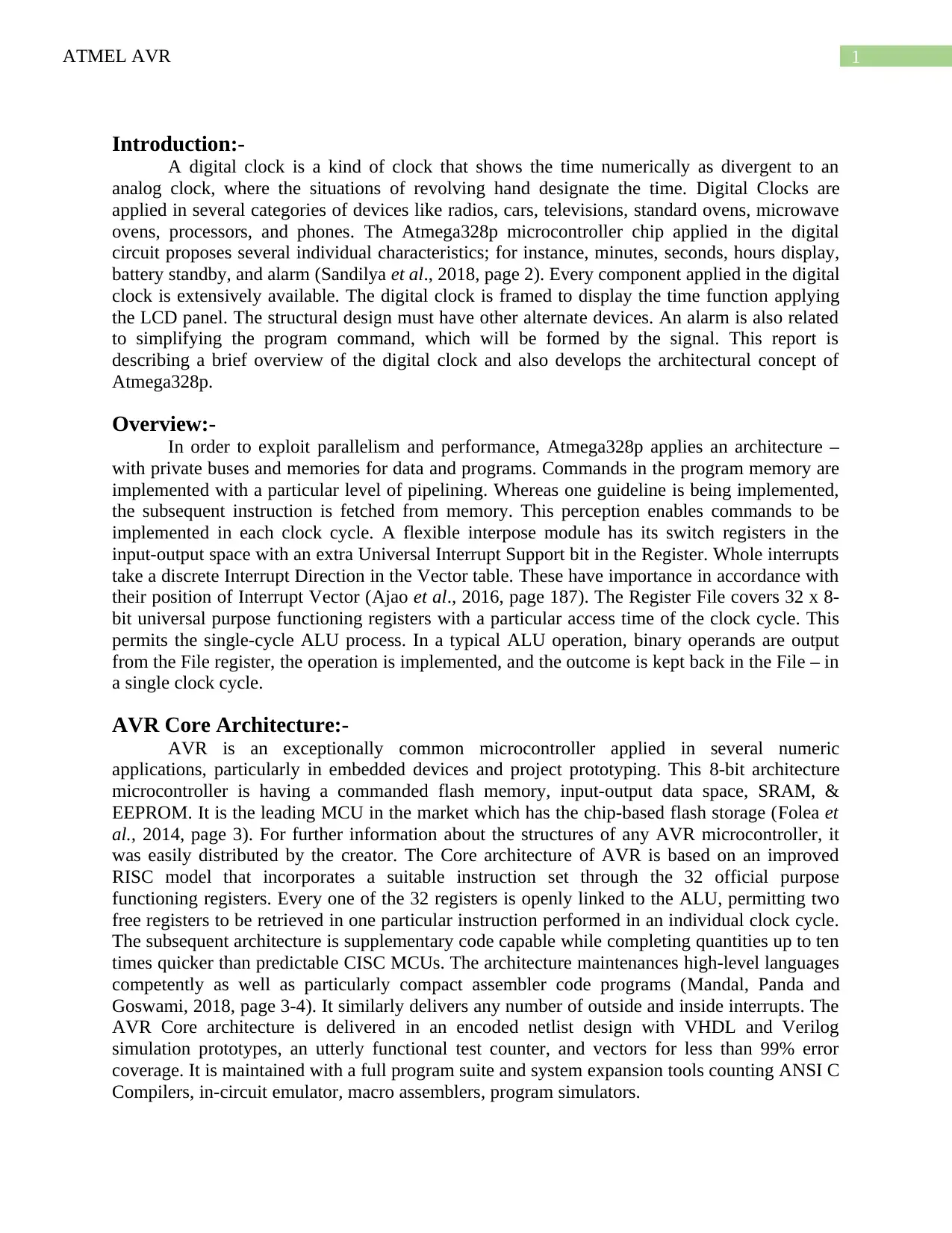
1ATMEL AVR
Introduction:-
A digital clock is a kind of clock that shows the time numerically as divergent to an
analog clock, where the situations of revolving hand designate the time. Digital Clocks are
applied in several categories of devices like radios, cars, televisions, standard ovens, microwave
ovens, processors, and phones. The Atmega328p microcontroller chip applied in the digital
circuit proposes several individual characteristics; for instance, minutes, seconds, hours display,
battery standby, and alarm (Sandilya et al., 2018, page 2). Every component applied in the digital
clock is extensively available. The digital clock is framed to display the time function applying
the LCD panel. The structural design must have other alternate devices. An alarm is also related
to simplifying the program command, which will be formed by the signal. This report is
describing a brief overview of the digital clock and also develops the architectural concept of
Atmega328p.
Overview:-
In order to exploit parallelism and performance, Atmega328p applies an architecture –
with private buses and memories for data and programs. Commands in the program memory are
implemented with a particular level of pipelining. Whereas one guideline is being implemented,
the subsequent instruction is fetched from memory. This perception enables commands to be
implemented in each clock cycle. A flexible interpose module has its switch registers in the
input-output space with an extra Universal Interrupt Support bit in the Register. Whole interrupts
take a discrete Interrupt Direction in the Vector table. These have importance in accordance with
their position of Interrupt Vector (Ajao et al., 2016, page 187). The Register File covers 32 x 8-
bit universal purpose functioning registers with a particular access time of the clock cycle. This
permits the single-cycle ALU process. In a typical ALU operation, binary operands are output
from the File register, the operation is implemented, and the outcome is kept back in the File – in
a single clock cycle.
AVR Core Architecture:-
AVR is an exceptionally common microcontroller applied in several numeric
applications, particularly in embedded devices and project prototyping. This 8-bit architecture
microcontroller is having a commanded flash memory, input-output data space, SRAM, &
EEPROM. It is the leading MCU in the market which has the chip-based flash storage (Folea et
al., 2014, page 3). For further information about the structures of any AVR microcontroller, it
was easily distributed by the creator. The Core architecture of AVR is based on an improved
RISC model that incorporates a suitable instruction set through the 32 official purpose
functioning registers. Every one of the 32 registers is openly linked to the ALU, permitting two
free registers to be retrieved in one particular instruction performed in an individual clock cycle.
The subsequent architecture is supplementary code capable while completing quantities up to ten
times quicker than predictable CISC MCUs. The architecture maintenances high-level languages
competently as well as particularly compact assembler code programs (Mandal, Panda and
Goswami, 2018, page 3-4). It similarly delivers any number of outside and inside interrupts. The
AVR Core architecture is delivered in an encoded netlist design with VHDL and Verilog
simulation prototypes, an utterly functional test counter, and vectors for less than 99% error
coverage. It is maintained with a full program suite and system expansion tools counting ANSI C
Compilers, in-circuit emulator, macro assemblers, program simulators.
Introduction:-
A digital clock is a kind of clock that shows the time numerically as divergent to an
analog clock, where the situations of revolving hand designate the time. Digital Clocks are
applied in several categories of devices like radios, cars, televisions, standard ovens, microwave
ovens, processors, and phones. The Atmega328p microcontroller chip applied in the digital
circuit proposes several individual characteristics; for instance, minutes, seconds, hours display,
battery standby, and alarm (Sandilya et al., 2018, page 2). Every component applied in the digital
clock is extensively available. The digital clock is framed to display the time function applying
the LCD panel. The structural design must have other alternate devices. An alarm is also related
to simplifying the program command, which will be formed by the signal. This report is
describing a brief overview of the digital clock and also develops the architectural concept of
Atmega328p.
Overview:-
In order to exploit parallelism and performance, Atmega328p applies an architecture –
with private buses and memories for data and programs. Commands in the program memory are
implemented with a particular level of pipelining. Whereas one guideline is being implemented,
the subsequent instruction is fetched from memory. This perception enables commands to be
implemented in each clock cycle. A flexible interpose module has its switch registers in the
input-output space with an extra Universal Interrupt Support bit in the Register. Whole interrupts
take a discrete Interrupt Direction in the Vector table. These have importance in accordance with
their position of Interrupt Vector (Ajao et al., 2016, page 187). The Register File covers 32 x 8-
bit universal purpose functioning registers with a particular access time of the clock cycle. This
permits the single-cycle ALU process. In a typical ALU operation, binary operands are output
from the File register, the operation is implemented, and the outcome is kept back in the File – in
a single clock cycle.
AVR Core Architecture:-
AVR is an exceptionally common microcontroller applied in several numeric
applications, particularly in embedded devices and project prototyping. This 8-bit architecture
microcontroller is having a commanded flash memory, input-output data space, SRAM, &
EEPROM. It is the leading MCU in the market which has the chip-based flash storage (Folea et
al., 2014, page 3). For further information about the structures of any AVR microcontroller, it
was easily distributed by the creator. The Core architecture of AVR is based on an improved
RISC model that incorporates a suitable instruction set through the 32 official purpose
functioning registers. Every one of the 32 registers is openly linked to the ALU, permitting two
free registers to be retrieved in one particular instruction performed in an individual clock cycle.
The subsequent architecture is supplementary code capable while completing quantities up to ten
times quicker than predictable CISC MCUs. The architecture maintenances high-level languages
competently as well as particularly compact assembler code programs (Mandal, Panda and
Goswami, 2018, page 3-4). It similarly delivers any number of outside and inside interrupts. The
AVR Core architecture is delivered in an encoded netlist design with VHDL and Verilog
simulation prototypes, an utterly functional test counter, and vectors for less than 99% error
coverage. It is maintained with a full program suite and system expansion tools counting ANSI C
Compilers, in-circuit emulator, macro assemblers, program simulators.
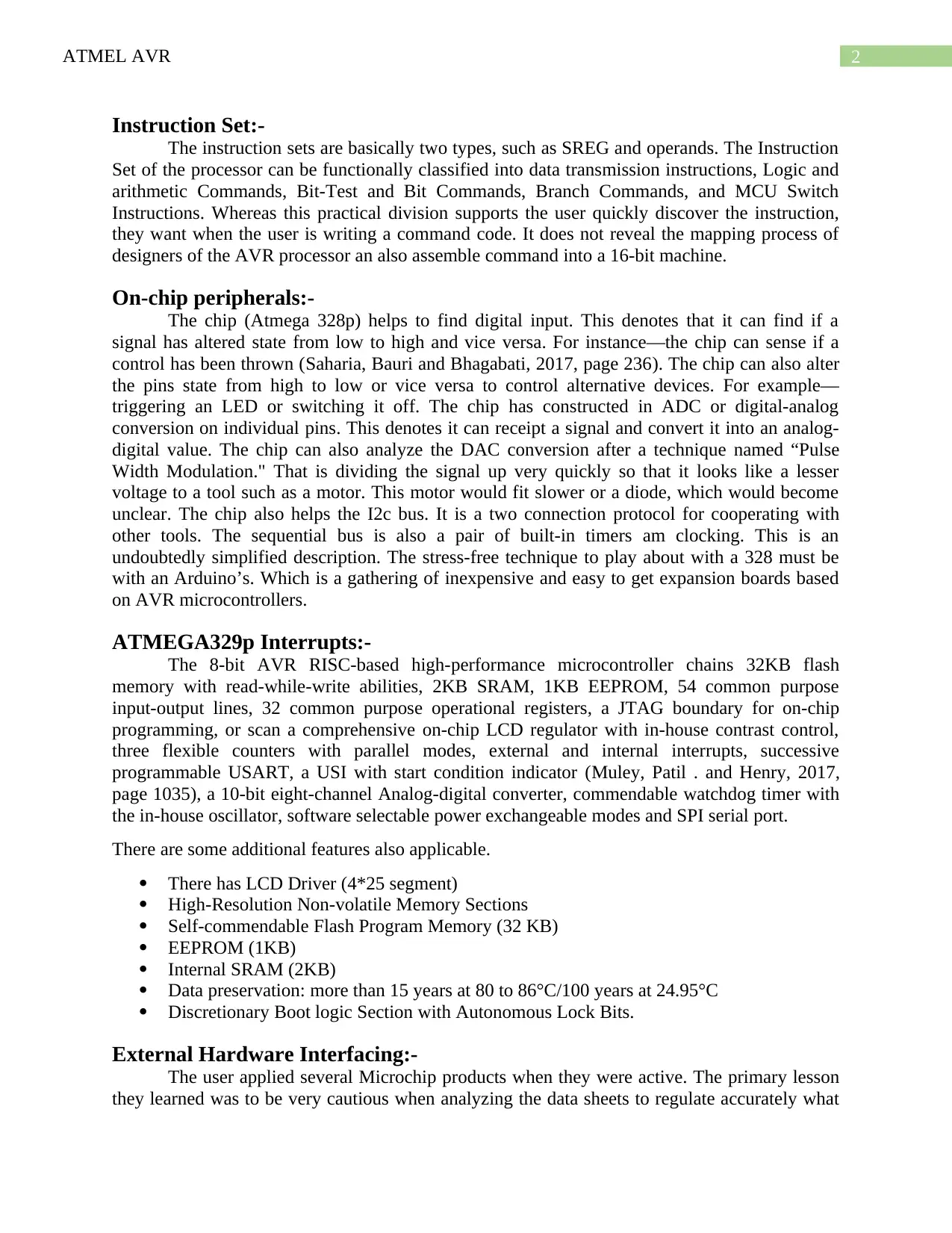
2ATMEL AVR
Instruction Set:-
The instruction sets are basically two types, such as SREG and operands. The Instruction
Set of the processor can be functionally classified into data transmission instructions, Logic and
arithmetic Commands, Bit-Test and Bit Commands, Branch Commands, and MCU Switch
Instructions. Whereas this practical division supports the user quickly discover the instruction,
they want when the user is writing a command code. It does not reveal the mapping process of
designers of the AVR processor an also assemble command into a 16-bit machine.
On-chip peripherals:-
The chip (Atmega 328p) helps to find digital input. This denotes that it can find if a
signal has altered state from low to high and vice versa. For instance—the chip can sense if a
control has been thrown (Saharia, Bauri and Bhagabati, 2017, page 236). The chip can also alter
the pins state from high to low or vice versa to control alternative devices. For example—
triggering an LED or switching it off. The chip has constructed in ADC or digital-analog
conversion on individual pins. This denotes it can receipt a signal and convert it into an analog-
digital value. The chip can also analyze the DAC conversion after a technique named “Pulse
Width Modulation." That is dividing the signal up very quickly so that it looks like a lesser
voltage to a tool such as a motor. This motor would fit slower or a diode, which would become
unclear. The chip also helps the I2c bus. It is a two connection protocol for cooperating with
other tools. The sequential bus is also a pair of built-in timers am clocking. This is an
undoubtedly simplified description. The stress-free technique to play about with a 328 must be
with an Arduino’s. Which is a gathering of inexpensive and easy to get expansion boards based
on AVR microcontrollers.
ATMEGA329p Interrupts:-
The 8-bit AVR RISC-based high-performance microcontroller chains 32KB flash
memory with read-while-write abilities, 2KB SRAM, 1KB EEPROM, 54 common purpose
input-output lines, 32 common purpose operational registers, a JTAG boundary for on-chip
programming, or scan a comprehensive on-chip LCD regulator with in-house contrast control,
three flexible counters with parallel modes, external and internal interrupts, successive
programmable USART, a USI with start condition indicator (Muley, Patil . and Henry, 2017,
page 1035), a 10-bit eight-channel Analog-digital converter, commendable watchdog timer with
the in-house oscillator, software selectable power exchangeable modes and SPI serial port.
There are some additional features also applicable.
There has LCD Driver (4*25 segment)
High-Resolution Non-volatile Memory Sections
Self-commendable Flash Program Memory (32 KB)
EEPROM (1KB)
Internal SRAM (2KB)
Data preservation: more than 15 years at 80 to 86°C/100 years at 24.95°C
Discretionary Boot logic Section with Autonomous Lock Bits.
External Hardware Interfacing:-
The user applied several Microchip products when they were active. The primary lesson
they learned was to be very cautious when analyzing the data sheets to regulate accurately what
Instruction Set:-
The instruction sets are basically two types, such as SREG and operands. The Instruction
Set of the processor can be functionally classified into data transmission instructions, Logic and
arithmetic Commands, Bit-Test and Bit Commands, Branch Commands, and MCU Switch
Instructions. Whereas this practical division supports the user quickly discover the instruction,
they want when the user is writing a command code. It does not reveal the mapping process of
designers of the AVR processor an also assemble command into a 16-bit machine.
On-chip peripherals:-
The chip (Atmega 328p) helps to find digital input. This denotes that it can find if a
signal has altered state from low to high and vice versa. For instance—the chip can sense if a
control has been thrown (Saharia, Bauri and Bhagabati, 2017, page 236). The chip can also alter
the pins state from high to low or vice versa to control alternative devices. For example—
triggering an LED or switching it off. The chip has constructed in ADC or digital-analog
conversion on individual pins. This denotes it can receipt a signal and convert it into an analog-
digital value. The chip can also analyze the DAC conversion after a technique named “Pulse
Width Modulation." That is dividing the signal up very quickly so that it looks like a lesser
voltage to a tool such as a motor. This motor would fit slower or a diode, which would become
unclear. The chip also helps the I2c bus. It is a two connection protocol for cooperating with
other tools. The sequential bus is also a pair of built-in timers am clocking. This is an
undoubtedly simplified description. The stress-free technique to play about with a 328 must be
with an Arduino’s. Which is a gathering of inexpensive and easy to get expansion boards based
on AVR microcontrollers.
ATMEGA329p Interrupts:-
The 8-bit AVR RISC-based high-performance microcontroller chains 32KB flash
memory with read-while-write abilities, 2KB SRAM, 1KB EEPROM, 54 common purpose
input-output lines, 32 common purpose operational registers, a JTAG boundary for on-chip
programming, or scan a comprehensive on-chip LCD regulator with in-house contrast control,
three flexible counters with parallel modes, external and internal interrupts, successive
programmable USART, a USI with start condition indicator (Muley, Patil . and Henry, 2017,
page 1035), a 10-bit eight-channel Analog-digital converter, commendable watchdog timer with
the in-house oscillator, software selectable power exchangeable modes and SPI serial port.
There are some additional features also applicable.
There has LCD Driver (4*25 segment)
High-Resolution Non-volatile Memory Sections
Self-commendable Flash Program Memory (32 KB)
EEPROM (1KB)
Internal SRAM (2KB)
Data preservation: more than 15 years at 80 to 86°C/100 years at 24.95°C
Discretionary Boot logic Section with Autonomous Lock Bits.
External Hardware Interfacing:-
The user applied several Microchip products when they were active. The primary lesson
they learned was to be very cautious when analyzing the data sheets to regulate accurately what
⊘ This is a preview!⊘
Do you want full access?
Subscribe today to unlock all pages.

Trusted by 1+ million students worldwide
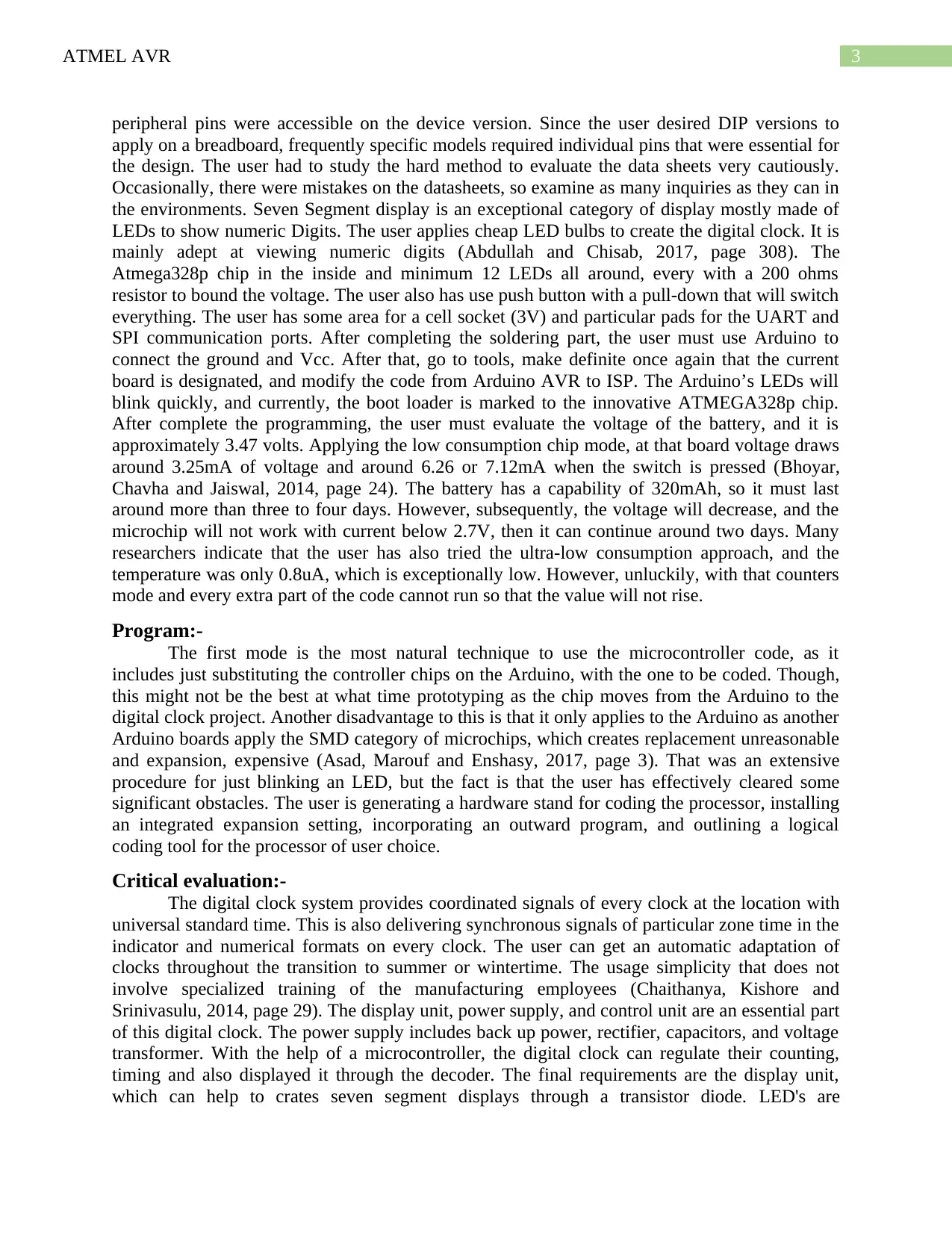
3ATMEL AVR
peripheral pins were accessible on the device version. Since the user desired DIP versions to
apply on a breadboard, frequently specific models required individual pins that were essential for
the design. The user had to study the hard method to evaluate the data sheets very cautiously.
Occasionally, there were mistakes on the datasheets, so examine as many inquiries as they can in
the environments. Seven Segment display is an exceptional category of display mostly made of
LEDs to show numeric Digits. The user applies cheap LED bulbs to create the digital clock. It is
mainly adept at viewing numeric digits (Abdullah and Chisab, 2017, page 308). The
Atmega328p chip in the inside and minimum 12 LEDs all around, every with a 200 ohms
resistor to bound the voltage. The user also has use push button with a pull-down that will switch
everything. The user has some area for a cell socket (3V) and particular pads for the UART and
SPI communication ports. After completing the soldering part, the user must use Arduino to
connect the ground and Vcc. After that, go to tools, make definite once again that the current
board is designated, and modify the code from Arduino AVR to ISP. The Arduino’s LEDs will
blink quickly, and currently, the boot loader is marked to the innovative ATMEGA328p chip.
After complete the programming, the user must evaluate the voltage of the battery, and it is
approximately 3.47 volts. Applying the low consumption chip mode, at that board voltage draws
around 3.25mA of voltage and around 6.26 or 7.12mA when the switch is pressed (Bhoyar,
Chavha and Jaiswal, 2014, page 24). The battery has a capability of 320mAh, so it must last
around more than three to four days. However, subsequently, the voltage will decrease, and the
microchip will not work with current below 2.7V, then it can continue around two days. Many
researchers indicate that the user has also tried the ultra-low consumption approach, and the
temperature was only 0.8uA, which is exceptionally low. However, unluckily, with that counters
mode and every extra part of the code cannot run so that the value will not rise.
Program:-
The first mode is the most natural technique to use the microcontroller code, as it
includes just substituting the controller chips on the Arduino, with the one to be coded. Though,
this might not be the best at what time prototyping as the chip moves from the Arduino to the
digital clock project. Another disadvantage to this is that it only applies to the Arduino as another
Arduino boards apply the SMD category of microchips, which creates replacement unreasonable
and expansion, expensive (Asad, Marouf and Enshasy, 2017, page 3). That was an extensive
procedure for just blinking an LED, but the fact is that the user has effectively cleared some
significant obstacles. The user is generating a hardware stand for coding the processor, installing
an integrated expansion setting, incorporating an outward program, and outlining a logical
coding tool for the processor of user choice.
Critical evaluation:-
The digital clock system provides coordinated signals of every clock at the location with
universal standard time. This is also delivering synchronous signals of particular zone time in the
indicator and numerical formats on every clock. The user can get an automatic adaptation of
clocks throughout the transition to summer or wintertime. The usage simplicity that does not
involve specialized training of the manufacturing employees (Chaithanya, Kishore and
Srinivasulu, 2014, page 29). The display unit, power supply, and control unit are an essential part
of this digital clock. The power supply includes back up power, rectifier, capacitors, and voltage
transformer. With the help of a microcontroller, the digital clock can regulate their counting,
timing and also displayed it through the decoder. The final requirements are the display unit,
which can help to crates seven segment displays through a transistor diode. LED's are
peripheral pins were accessible on the device version. Since the user desired DIP versions to
apply on a breadboard, frequently specific models required individual pins that were essential for
the design. The user had to study the hard method to evaluate the data sheets very cautiously.
Occasionally, there were mistakes on the datasheets, so examine as many inquiries as they can in
the environments. Seven Segment display is an exceptional category of display mostly made of
LEDs to show numeric Digits. The user applies cheap LED bulbs to create the digital clock. It is
mainly adept at viewing numeric digits (Abdullah and Chisab, 2017, page 308). The
Atmega328p chip in the inside and minimum 12 LEDs all around, every with a 200 ohms
resistor to bound the voltage. The user also has use push button with a pull-down that will switch
everything. The user has some area for a cell socket (3V) and particular pads for the UART and
SPI communication ports. After completing the soldering part, the user must use Arduino to
connect the ground and Vcc. After that, go to tools, make definite once again that the current
board is designated, and modify the code from Arduino AVR to ISP. The Arduino’s LEDs will
blink quickly, and currently, the boot loader is marked to the innovative ATMEGA328p chip.
After complete the programming, the user must evaluate the voltage of the battery, and it is
approximately 3.47 volts. Applying the low consumption chip mode, at that board voltage draws
around 3.25mA of voltage and around 6.26 or 7.12mA when the switch is pressed (Bhoyar,
Chavha and Jaiswal, 2014, page 24). The battery has a capability of 320mAh, so it must last
around more than three to four days. However, subsequently, the voltage will decrease, and the
microchip will not work with current below 2.7V, then it can continue around two days. Many
researchers indicate that the user has also tried the ultra-low consumption approach, and the
temperature was only 0.8uA, which is exceptionally low. However, unluckily, with that counters
mode and every extra part of the code cannot run so that the value will not rise.
Program:-
The first mode is the most natural technique to use the microcontroller code, as it
includes just substituting the controller chips on the Arduino, with the one to be coded. Though,
this might not be the best at what time prototyping as the chip moves from the Arduino to the
digital clock project. Another disadvantage to this is that it only applies to the Arduino as another
Arduino boards apply the SMD category of microchips, which creates replacement unreasonable
and expansion, expensive (Asad, Marouf and Enshasy, 2017, page 3). That was an extensive
procedure for just blinking an LED, but the fact is that the user has effectively cleared some
significant obstacles. The user is generating a hardware stand for coding the processor, installing
an integrated expansion setting, incorporating an outward program, and outlining a logical
coding tool for the processor of user choice.
Critical evaluation:-
The digital clock system provides coordinated signals of every clock at the location with
universal standard time. This is also delivering synchronous signals of particular zone time in the
indicator and numerical formats on every clock. The user can get an automatic adaptation of
clocks throughout the transition to summer or wintertime. The usage simplicity that does not
involve specialized training of the manufacturing employees (Chaithanya, Kishore and
Srinivasulu, 2014, page 29). The display unit, power supply, and control unit are an essential part
of this digital clock. The power supply includes back up power, rectifier, capacitors, and voltage
transformer. With the help of a microcontroller, the digital clock can regulate their counting,
timing and also displayed it through the decoder. The final requirements are the display unit,
which can help to crates seven segment displays through a transistor diode. LED's are
Paraphrase This Document
Need a fresh take? Get an instant paraphrase of this document with our AI Paraphraser
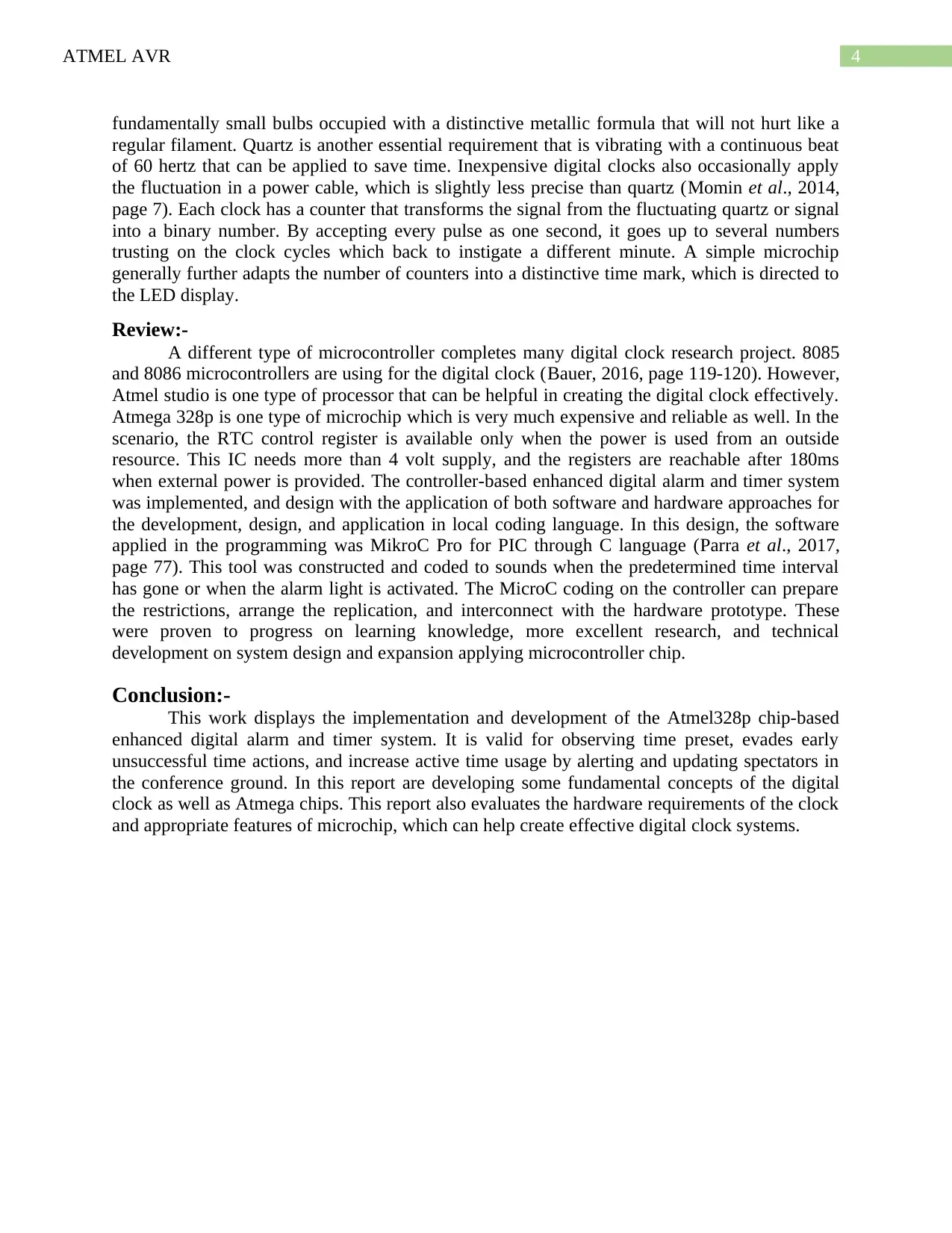
4ATMEL AVR
fundamentally small bulbs occupied with a distinctive metallic formula that will not hurt like a
regular filament. Quartz is another essential requirement that is vibrating with a continuous beat
of 60 hertz that can be applied to save time. Inexpensive digital clocks also occasionally apply
the fluctuation in a power cable, which is slightly less precise than quartz (Momin et al., 2014,
page 7). Each clock has a counter that transforms the signal from the fluctuating quartz or signal
into a binary number. By accepting every pulse as one second, it goes up to several numbers
trusting on the clock cycles which back to instigate a different minute. A simple microchip
generally further adapts the number of counters into a distinctive time mark, which is directed to
the LED display.
Review:-
A different type of microcontroller completes many digital clock research project. 8085
and 8086 microcontrollers are using for the digital clock (Bauer, 2016, page 119-120). However,
Atmel studio is one type of processor that can be helpful in creating the digital clock effectively.
Atmega 328p is one type of microchip which is very much expensive and reliable as well. In the
scenario, the RTC control register is available only when the power is used from an outside
resource. This IC needs more than 4 volt supply, and the registers are reachable after 180ms
when external power is provided. The controller-based enhanced digital alarm and timer system
was implemented, and design with the application of both software and hardware approaches for
the development, design, and application in local coding language. In this design, the software
applied in the programming was MikroC Pro for PIC through C language (Parra et al., 2017,
page 77). This tool was constructed and coded to sounds when the predetermined time interval
has gone or when the alarm light is activated. The MicroC coding on the controller can prepare
the restrictions, arrange the replication, and interconnect with the hardware prototype. These
were proven to progress on learning knowledge, more excellent research, and technical
development on system design and expansion applying microcontroller chip.
Conclusion:-
This work displays the implementation and development of the Atmel328p chip-based
enhanced digital alarm and timer system. It is valid for observing time preset, evades early
unsuccessful time actions, and increase active time usage by alerting and updating spectators in
the conference ground. In this report are developing some fundamental concepts of the digital
clock as well as Atmega chips. This report also evaluates the hardware requirements of the clock
and appropriate features of microchip, which can help create effective digital clock systems.
fundamentally small bulbs occupied with a distinctive metallic formula that will not hurt like a
regular filament. Quartz is another essential requirement that is vibrating with a continuous beat
of 60 hertz that can be applied to save time. Inexpensive digital clocks also occasionally apply
the fluctuation in a power cable, which is slightly less precise than quartz (Momin et al., 2014,
page 7). Each clock has a counter that transforms the signal from the fluctuating quartz or signal
into a binary number. By accepting every pulse as one second, it goes up to several numbers
trusting on the clock cycles which back to instigate a different minute. A simple microchip
generally further adapts the number of counters into a distinctive time mark, which is directed to
the LED display.
Review:-
A different type of microcontroller completes many digital clock research project. 8085
and 8086 microcontrollers are using for the digital clock (Bauer, 2016, page 119-120). However,
Atmel studio is one type of processor that can be helpful in creating the digital clock effectively.
Atmega 328p is one type of microchip which is very much expensive and reliable as well. In the
scenario, the RTC control register is available only when the power is used from an outside
resource. This IC needs more than 4 volt supply, and the registers are reachable after 180ms
when external power is provided. The controller-based enhanced digital alarm and timer system
was implemented, and design with the application of both software and hardware approaches for
the development, design, and application in local coding language. In this design, the software
applied in the programming was MikroC Pro for PIC through C language (Parra et al., 2017,
page 77). This tool was constructed and coded to sounds when the predetermined time interval
has gone or when the alarm light is activated. The MicroC coding on the controller can prepare
the restrictions, arrange the replication, and interconnect with the hardware prototype. These
were proven to progress on learning knowledge, more excellent research, and technical
development on system design and expansion applying microcontroller chip.
Conclusion:-
This work displays the implementation and development of the Atmel328p chip-based
enhanced digital alarm and timer system. It is valid for observing time preset, evades early
unsuccessful time actions, and increase active time usage by alerting and updating spectators in
the conference ground. In this report are developing some fundamental concepts of the digital
clock as well as Atmega chips. This report also evaluates the hardware requirements of the clock
and appropriate features of microchip, which can help create effective digital clock systems.
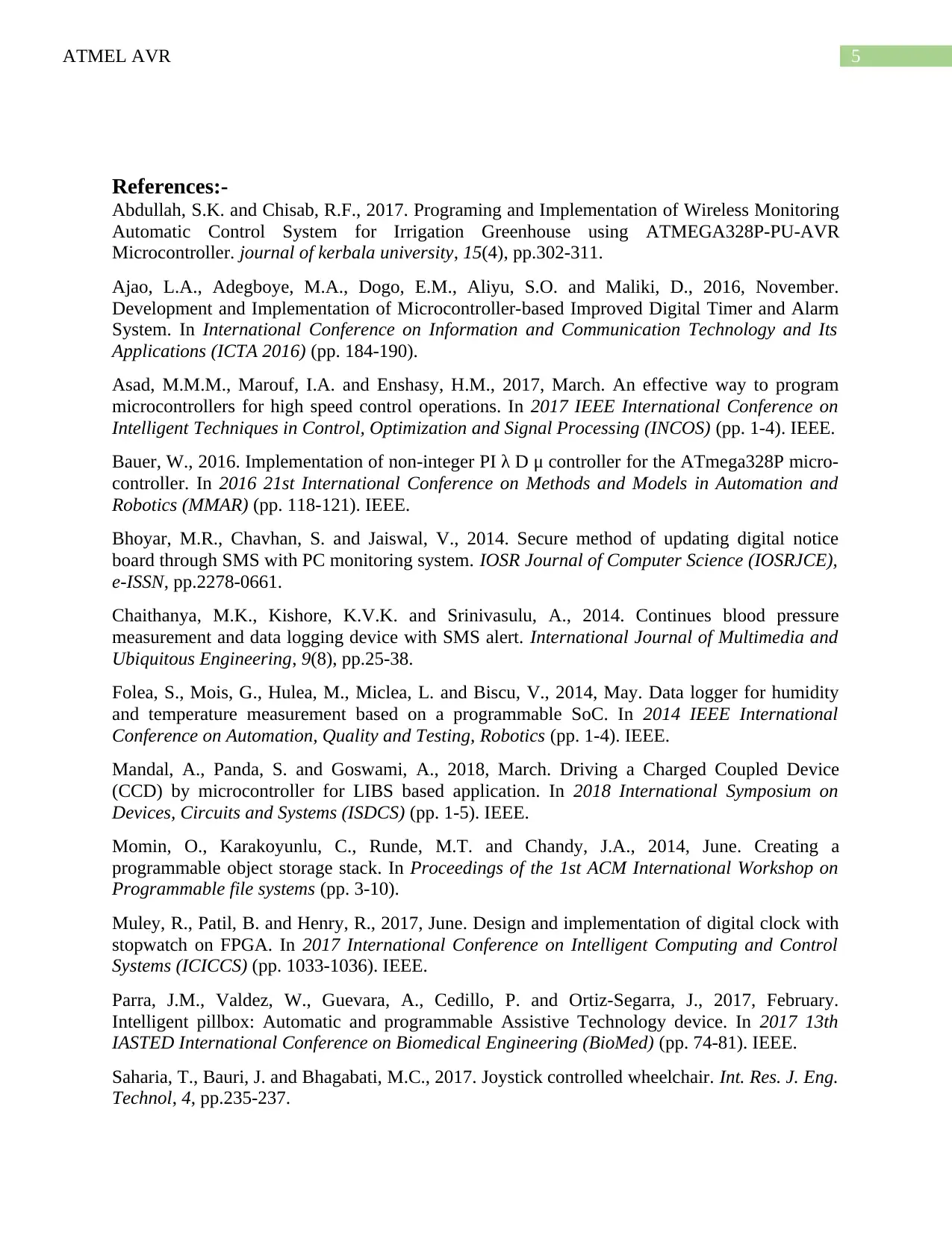
5ATMEL AVR
References:-
Abdullah, S.K. and Chisab, R.F., 2017. Programing and Implementation of Wireless Monitoring
Automatic Control System for Irrigation Greenhouse using ATMEGA328P-PU-AVR
Microcontroller. journal of kerbala university, 15(4), pp.302-311.
Ajao, L.A., Adegboye, M.A., Dogo, E.M., Aliyu, S.O. and Maliki, D., 2016, November.
Development and Implementation of Microcontroller-based Improved Digital Timer and Alarm
System. In International Conference on Information and Communication Technology and Its
Applications (ICTA 2016) (pp. 184-190).
Asad, M.M.M., Marouf, I.A. and Enshasy, H.M., 2017, March. An effective way to program
microcontrollers for high speed control operations. In 2017 IEEE International Conference on
Intelligent Techniques in Control, Optimization and Signal Processing (INCOS) (pp. 1-4). IEEE.
Bauer, W., 2016. Implementation of non-integer PI λ D μ controller for the ATmega328P micro-
controller. In 2016 21st International Conference on Methods and Models in Automation and
Robotics (MMAR) (pp. 118-121). IEEE.
Bhoyar, M.R., Chavhan, S. and Jaiswal, V., 2014. Secure method of updating digital notice
board through SMS with PC monitoring system. IOSR Journal of Computer Science (IOSRJCE),
e-ISSN, pp.2278-0661.
Chaithanya, M.K., Kishore, K.V.K. and Srinivasulu, A., 2014. Continues blood pressure
measurement and data logging device with SMS alert. International Journal of Multimedia and
Ubiquitous Engineering, 9(8), pp.25-38.
Folea, S., Mois, G., Hulea, M., Miclea, L. and Biscu, V., 2014, May. Data logger for humidity
and temperature measurement based on a programmable SoC. In 2014 IEEE International
Conference on Automation, Quality and Testing, Robotics (pp. 1-4). IEEE.
Mandal, A., Panda, S. and Goswami, A., 2018, March. Driving a Charged Coupled Device
(CCD) by microcontroller for LIBS based application. In 2018 International Symposium on
Devices, Circuits and Systems (ISDCS) (pp. 1-5). IEEE.
Momin, O., Karakoyunlu, C., Runde, M.T. and Chandy, J.A., 2014, June. Creating a
programmable object storage stack. In Proceedings of the 1st ACM International Workshop on
Programmable file systems (pp. 3-10).
Muley, R., Patil, B. and Henry, R., 2017, June. Design and implementation of digital clock with
stopwatch on FPGA. In 2017 International Conference on Intelligent Computing and Control
Systems (ICICCS) (pp. 1033-1036). IEEE.
Parra, J.M., Valdez, W., Guevara, A., Cedillo, P. and Ortiz-Segarra, J., 2017, February.
Intelligent pillbox: Automatic and programmable Assistive Technology device. In 2017 13th
IASTED International Conference on Biomedical Engineering (BioMed) (pp. 74-81). IEEE.
Saharia, T., Bauri, J. and Bhagabati, M.C., 2017. Joystick controlled wheelchair. Int. Res. J. Eng.
Technol, 4, pp.235-237.
References:-
Abdullah, S.K. and Chisab, R.F., 2017. Programing and Implementation of Wireless Monitoring
Automatic Control System for Irrigation Greenhouse using ATMEGA328P-PU-AVR
Microcontroller. journal of kerbala university, 15(4), pp.302-311.
Ajao, L.A., Adegboye, M.A., Dogo, E.M., Aliyu, S.O. and Maliki, D., 2016, November.
Development and Implementation of Microcontroller-based Improved Digital Timer and Alarm
System. In International Conference on Information and Communication Technology and Its
Applications (ICTA 2016) (pp. 184-190).
Asad, M.M.M., Marouf, I.A. and Enshasy, H.M., 2017, March. An effective way to program
microcontrollers for high speed control operations. In 2017 IEEE International Conference on
Intelligent Techniques in Control, Optimization and Signal Processing (INCOS) (pp. 1-4). IEEE.
Bauer, W., 2016. Implementation of non-integer PI λ D μ controller for the ATmega328P micro-
controller. In 2016 21st International Conference on Methods and Models in Automation and
Robotics (MMAR) (pp. 118-121). IEEE.
Bhoyar, M.R., Chavhan, S. and Jaiswal, V., 2014. Secure method of updating digital notice
board through SMS with PC monitoring system. IOSR Journal of Computer Science (IOSRJCE),
e-ISSN, pp.2278-0661.
Chaithanya, M.K., Kishore, K.V.K. and Srinivasulu, A., 2014. Continues blood pressure
measurement and data logging device with SMS alert. International Journal of Multimedia and
Ubiquitous Engineering, 9(8), pp.25-38.
Folea, S., Mois, G., Hulea, M., Miclea, L. and Biscu, V., 2014, May. Data logger for humidity
and temperature measurement based on a programmable SoC. In 2014 IEEE International
Conference on Automation, Quality and Testing, Robotics (pp. 1-4). IEEE.
Mandal, A., Panda, S. and Goswami, A., 2018, March. Driving a Charged Coupled Device
(CCD) by microcontroller for LIBS based application. In 2018 International Symposium on
Devices, Circuits and Systems (ISDCS) (pp. 1-5). IEEE.
Momin, O., Karakoyunlu, C., Runde, M.T. and Chandy, J.A., 2014, June. Creating a
programmable object storage stack. In Proceedings of the 1st ACM International Workshop on
Programmable file systems (pp. 3-10).
Muley, R., Patil, B. and Henry, R., 2017, June. Design and implementation of digital clock with
stopwatch on FPGA. In 2017 International Conference on Intelligent Computing and Control
Systems (ICICCS) (pp. 1033-1036). IEEE.
Parra, J.M., Valdez, W., Guevara, A., Cedillo, P. and Ortiz-Segarra, J., 2017, February.
Intelligent pillbox: Automatic and programmable Assistive Technology device. In 2017 13th
IASTED International Conference on Biomedical Engineering (BioMed) (pp. 74-81). IEEE.
Saharia, T., Bauri, J. and Bhagabati, M.C., 2017. Joystick controlled wheelchair. Int. Res. J. Eng.
Technol, 4, pp.235-237.
⊘ This is a preview!⊘
Do you want full access?
Subscribe today to unlock all pages.

Trusted by 1+ million students worldwide

6ATMEL AVR
Sandilya, K.S., Eswari, M., Remadevi, G., Bini, B. and Madhavan, A., 2018, December. Design
for a Programmable Alarm Clock using Alphanumeric Display (PACAD). In 2018 IEEE
International Conference on Computational Intelligence and Computing Research (ICCIC) (pp.
1-4). IEEE.
Sandilya, K.S., Eswari, M., Remadevi, G., Bini, B. and Madhavan, A., 2018, December. Design
for a Programmable Alarm Clock using Alphanumeric Display (PACAD). In 2018 IEEE
International Conference on Computational Intelligence and Computing Research (ICCIC) (pp.
1-4). IEEE.
1 out of 7
Your All-in-One AI-Powered Toolkit for Academic Success.
+13062052269
info@desklib.com
Available 24*7 on WhatsApp / Email
![[object Object]](/_next/static/media/star-bottom.7253800d.svg)
Unlock your academic potential
Copyright © 2020–2025 A2Z Services. All Rights Reserved. Developed and managed by ZUCOL.

